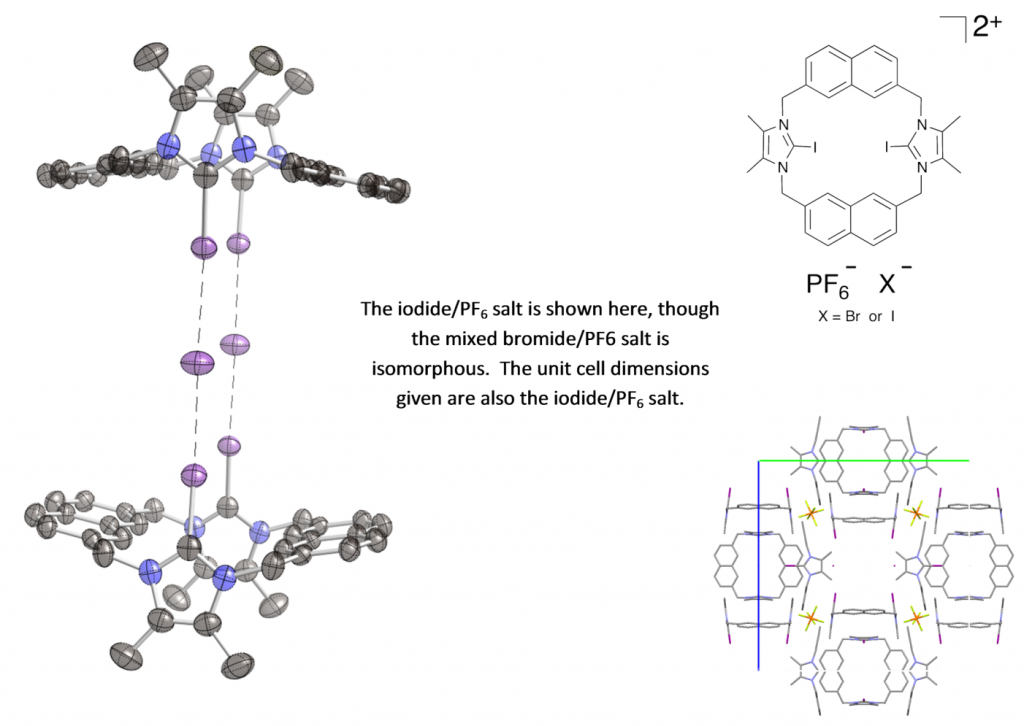The results have just been announced for the latest round of applications to the John Fell Oxford University Research Fund. Our proposal for funding for a temperature controlled Peltier stage microscope with polarizing filters for the study of solid-state phase transitions in crystalline materials was successful. Polarized light allows the ready detection of discontinuous changes in the anisotropy of a material during heating or cooling since discontinuity in any property is symptomatic of a phase change (an order-disorder transformation, a change in crystal symmetry, or the formation of a completely new phase). Studying such phase changes using a temperature controlled stage can assist in optimising conditions for obtaining a given form of a material, and also leading to an understanding the nature or mechanism of the transformation.
Presented by: Nicholas G. White & Dr. Fabiola Zapata
Research Leader: Prof. Paul D. Beer
Published: Journal of the American Chemical Society
Both the mixed bromide/PF6 and mixed iodide/PF6 salt of this bis-iodoimidazolium macrocycle crystallize in the unusual cubic spacegroup I m -3 (there are currently only six organic structures in this spacegroup in the CSD). The macrocycle binds anions strongly and selectively in competitive methanol/water solvent mixtures, with anions being bound solely by halogen-bonding interactions. In the solid state, the both the bromide and iodide salts of the macrocycle exist as a dimer, with two macrocycles each pointing at two halide anions. Experiments are being undertaken to see if this arrangement occurs in solution.
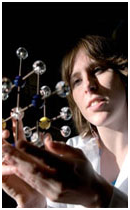
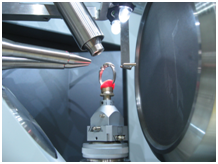 Not content with showing off the eye-catching brilliance of her new diamond engagement ring, final year Inorganic Chemistry student Rowena Scott wanted to reveal the beautiful symmetry of its atomic structure. She recorded an X-ray diffraction pattern from the diamond using one of the Chemistry Department’s new state of the art, SuperNova dual source X‑ray diffractometers.
Not content with showing off the eye-catching brilliance of her new diamond engagement ring, final year Inorganic Chemistry student Rowena Scott wanted to reveal the beautiful symmetry of its atomic structure. She recorded an X-ray diffraction pattern from the diamond using one of the Chemistry Department’s new state of the art, SuperNova dual source X‑ray diffractometers.
Rowena’s current research project with Dr Simon Clarke involves the synthesis of iron chalcogenide superconductors. The structures of these materials are then determined using single crystal X-ray diffraction techniques.
Chemical Crystallography Service manager, Dr Amber Thompson said “We see a wide range of materials of varying crystallinity from many research groups in the Department of Chemistry, usually grown at the bottom of glass schlenks or flasks; it’s not often that such a lovely crystal turns up mounted in a band of gold”.
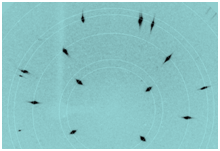 The diffracted X-rays were measured while rotating the diamond in an X-ray beam. The resulting diffraction pattern shows the position and intensity of the beams diffracted by the organised structure of carbon atoms in the crystal. The white rings overlaid on the image indicate the angles at which diamond peaks are expected to occur, which agree with the collected data.
The diffracted X-rays were measured while rotating the diamond in an X-ray beam. The resulting diffraction pattern shows the position and intensity of the beams diffracted by the organised structure of carbon atoms in the crystal. The white rings overlaid on the image indicate the angles at which diamond peaks are expected to occur, which agree with the collected data.
Diamond diffracts X-rays so efficiently that the X-ray generator had to be run at 10% of its usual power in order to avoid overloading the X-ray detector.
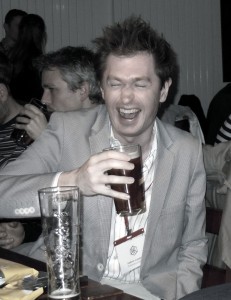 Andrew and his research group are close associates of Chem. Cryst.. We share group meetings and, although they have some very strange ideas about what constitutes a single crystal, they collect data in the lab.
Andrew and his research group are close associates of Chem. Cryst.. We share group meetings and, although they have some very strange ideas about what constitutes a single crystal, they collect data in the lab.
For more information, see their webpage.
 Keith Prout died quite suddenly in September 2007 after a short illness.
Keith Prout died quite suddenly in September 2007 after a short illness.
Although he had been officially retired for several years, he was continuing an active research program with Nick Rees combining X-ray and NMR studies. X-ray structure analysis gives information about disorder and thermal vibrations in crystals. When combined with solid state NMR a complete dynamic profile of the crystal can be obtained.
Previous studies of penicillins, ansa-titanocenes and tri-ethyl phosphate molecular complexes with various hosts suggest a variety of molecular motions in addition to the ‘translation-libration-screw’ motion derived from the crystallographic atomic displacement parameters. He also studied order/disorder phase transitions, molecular motion and chiral selectivity in deoxycholic acid molecular complexes.
 James is mathematician by training, who became a a particle physicist and now applies his skills to understanding some of the problems associated with errors in least-squares refinement. He is working on programming an error analysis library.
James is mathematician by training, who became a a particle physicist and now applies his skills to understanding some of the problems associated with errors in least-squares refinement. He is working on programming an error analysis library.
Mustapha is a Senior Research Associate in the group and is a highly experienced and efficient programmer. His specialism is C++ and he is responsible for the Small Molecule ToolKit, SMTK.
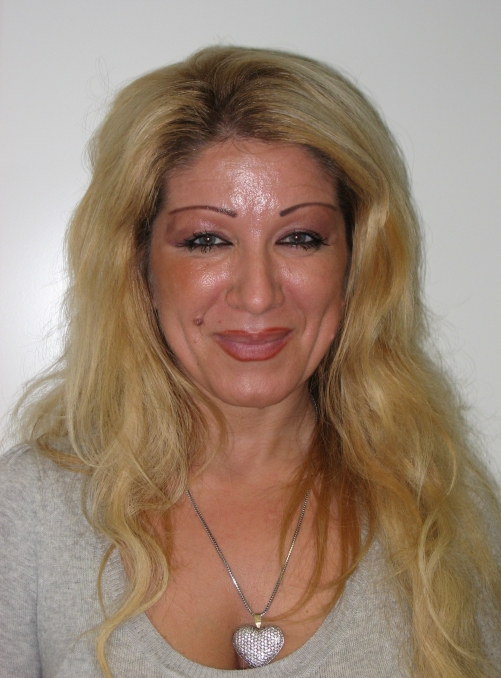 Violeta is an assistant professor in the Chemistry Department at the University of Novi Sad, Serbia. She obtained her Ph.D. in coordination chemistry studying the synthesis, structure and biological activity of transition metal compounds and visited for a few months to learn more about crystallography.
Violeta is an assistant professor in the Chemistry Department at the University of Novi Sad, Serbia. She obtained her Ph.D. in coordination chemistry studying the synthesis, structure and biological activity of transition metal compounds and visited for a few months to learn more about crystallography.
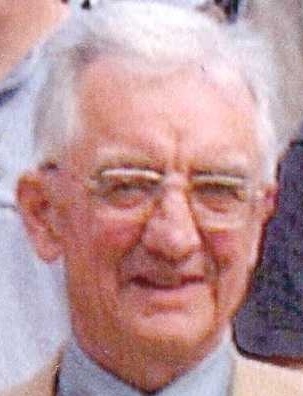 Terry worked for the Atomic Energy Research Establishment, Harwell for many years before he joined Chem. Cryst.
Terry worked for the Atomic Energy Research Establishment, Harwell for many years before he joined Chem. Cryst.
Terry was one of the pioneers of the use of neutron scattering in the United Kingdom and a founder member of the BCA. Although interested in many areas of crystallography, his particular specialities are neutron scattering studies of crystal structures and lattice dynamics of inorganic materials. Recent interests are the determination of the crystal structures of the oxides of uranium and the nature of the phase transitions in U4O9. The oxide studies are undertaken in collaboration with Frederico Garrido of the University of Paris, Lech Nowicki of the Soltan Institute of Nuclear Physics, Warsaw and Alberto Albinati of the University of Milan.
The author of a number of highly regarded books, there is a prize awarded in his honour sponsored by the Institute of Physics and the Royal Society of Chemistry.
